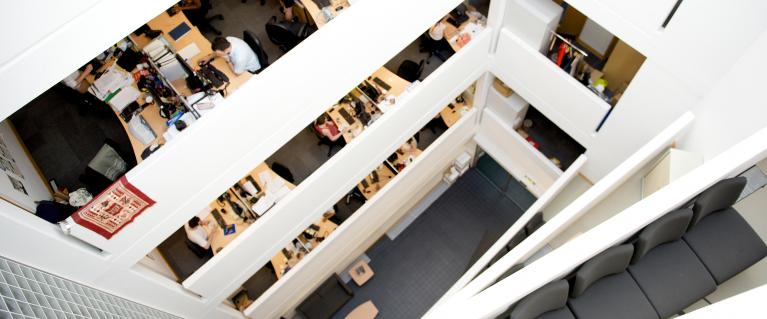
Energy in buildings
We’re helping London’s homes, businesses and public buildings to use less energy and save money on their energy bills.
Improving our existing building stock
Our two Retrofit Accelerator programmes for homes and workplaces involve using new technology on old buildings to make them more energy efficient:
Retrofit Accelerator - Homes - we’re making London’s homes warmer and more energy efficient through Retrofit Accelerator, the award winning domestic retrofit programme previously known as 'RE:NEW'. Retrofit Accelerator helps organisations such as London boroughs, housing associations, and universities to implement retrofit projects helping to cut carbon emissions and alleviate fuel poverty.
Retrofit Accelerator - Workplaces - we’re helping London’s public buildings to cut their energy consumption through Retrofit Accelerator - Workplaces, the award winning non-domestic retrofit programme previously known as 'RE:FIT'. Retrofit Accelerator - Workplaces offers support to London boroughs, schools, universities, hospitals, leisure centres and museums to implement retrofit projects and achieve large financial savings.
Energy Leap - in his vision, A City for all Londoners, the Mayor committed to developing new and innovative approaches to energy efficiency, starting with a trial of net-zero energy retrofitting of homes. The Mayor allocated £450,000 capital funding for the Energy Leap Project which will match fund up to ten zero energy retrofit projects.
Quick wins for commercial buildings
We have worked with our London Business Climate Leaders and Better Buildings Partnership to create a list of measures, or 'quick wins', that can be taken to make sure that London’s commercial buildings are operating as energy efficiently as possible. With many buildings consuming two to five times more energy than they need to, these “quick wins” represent a simple and practical way to reduce energy consumption.
Download this quick wins checklist and see how many you can undertake in your workplace. Take it to your landlord, facilities management team, engineer or Buildings Management System contractor, and persuade them to carry out the actions. Enlist the support of others in your organisation in carrying out some of the routine checks.
Quick wins to reduce building energy consumption
Improving the energy performance of new buildings
We are making sure new buildings are designed and built in a way that cuts energy use and carbon emissions through our energy planning policies. The aim is make sure that Londoners have excellent, energy efficient and comfortable homes - both now and in the years ahead.
Developers must follow the energy hierarchy when planning a new building. This means:
- being lean: using less energy, by improving the energy efficiency of the building itself, so less energy is needed for heat
- being clean: supplying energy efficiently, for example by using district heat networks
- being green: using renewable energy technologies, like solar photovoltaic panels or heat pumps.
We work with local planning authorities and developers to make sure that new projects follow this hierarchy. They must also meet the targets in Policy 5.2 of the London Plan to reduce carbon dioxide (CO2) emissions in new buildings.
Major development proposals must have an energy strategy which shows how they are applying the hierarchy above. It must also detail how the development will meet targets to cut CO2 emissions. The Energy Assessment Guidance helps developers and energy consultants produce an energy strategy.
Each year we report what developers are doing to cut CO2 emissions from proposed buildings. This energy monitoring report also has information on the technologies that are going to be installed.
Overheating and cooling
Overheating in homes (and associated increased demand for cooling such as air conditioning) is the phenomenon of a person experiencing excessive or prolonged high temperatures within their home, resulting from internal and/or external heat gains, and which leads to adverse effects on their comfort, health or productivity.
Overheating disproportionality affects vulnerable members of the community such as elderly.
Overheating in homes is being increasingly recognised by the building industry as a significant and growing problem given:
-
Increasing average temperatures and hotter summers due to climate change.
-
A growing and ageing population.
-
Urbanisation and increasing housing densities.
-
Construction practices – improving energy efficiency to meet higher standards and air tightness for winter; and increasing glazing proportions.
We’re helping developers of new homes in London to ensure potential for overheating is considered early in the planning and design process. We have commissioned research Creating benchmarks for cooling demand in new residential developments to develop a set of good practice cooling energy demand benchmarks for typical apartment dwelling types, based on reasonable design measures.
The research establishes good practice benchmarks based on dwelling designs which include reasonable design measures to reduce the need of active cooling and the risk of overheating in compliance with the cooling hierarchy identified in London Plan Policy 5.9. In summary it finds:
-
Climate change will have a big influence on the ability of a passive design strategies for new development to be effective in the long-term.
-
There is no ‘one size fits all’- design approaches should be bespoke to type of building, occupants, expected lifetime and location.
-
The ability to naturally ventilate a dwelling has a major impact on its cooling demand, however, this benefit will reduce as external conditions get warmer.
-
Building designers should maximise opportunities for cross ventilation.
The research includes a simple checklist which can be used to help determine level of overheating risk and compliments existing guidance that we issue to developers when preparing energy assessments for new development.
Need a document on this page in an accessible format?
If you use assistive technology (such as a screen reader) and need a version of a PDF or other document on this page in a more accessible format, please get in touch via our online form and tell us which format you need.
It will also help us if you tell us which assistive technology you use. We’ll consider your request and get back to you in 5 working days.